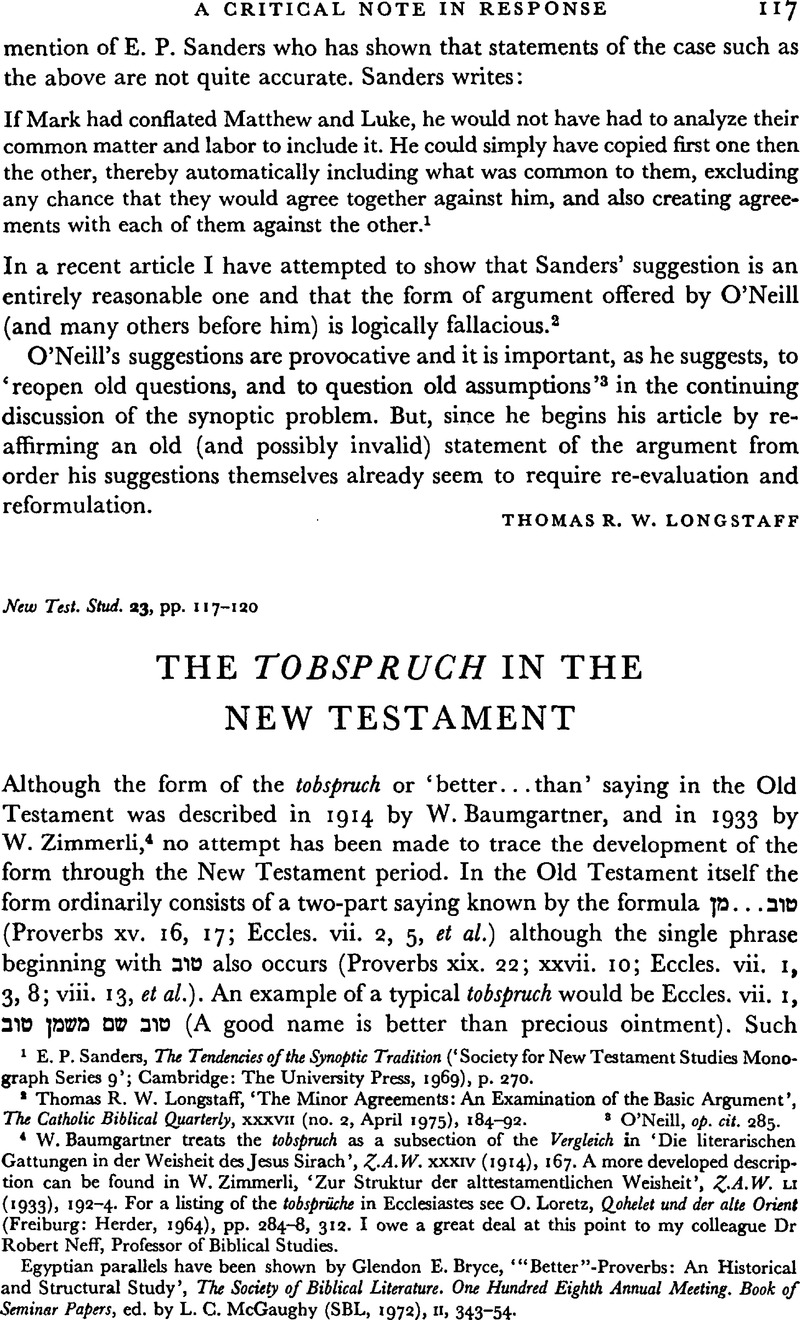Article contents
The Tobspruch in the New Testament
Published online by Cambridge University Press: 05 February 2009
Abstract

- Type
- Short Studies
- Information
- Copyright
- Copyright © Cambridge University Press 1976
References
page 117 note 4 Baumgartner, W. treats the tobspruchGoogle Scholar as a subsection of the Vergleich in ‘Die literarischen Gattungen in der Weisheit des Jesus Sirach’, Z.A.W. xxxiv (1914), 167.Google Scholar A more developed description can be found in Zimmerli, W., ‘Zur Struktur der alttestamentlichen Weisheit’, Z.A.W. LI (1933), 192–4.Google Scholar For a listing of the tobsprüche in Ecclesiastes see Loretz, O., Qohelet und der alte Orient (Freiburg: Herder, 1964), pp. 284–8, 312.Google Scholar I owe a great deal at this point to my colleague Dr Robert Neff, Professor of Biblical Studies.
Egyptian parallels have been shown by Bryce, Glendon E., ‘“Better”-Proverbs: An Historical and Structural Study’, The Society of Biblical Literature. One Hundred Eighth Annual Meeting. Book of Seminar Papers, ed. by McGaughy, L. C. (SBL, 1972), II, 343–54.Google Scholar
page 118 note 1 Possibly ix. 49 was a fifth tobspruch in this collection which like ix. 42 was broken in the redactional adaptation. Originally it may have read: ![]() , but the apodosis was transferred to its present position in order to clarify the (redemptive) harshness of the prior tobsprüche.
, but the apodosis was transferred to its present position in order to clarify the (redemptive) harshness of the prior tobsprüche.
page 119 note 1 Taking the second μηδέ as a connecting particle like και μή, rather than the third item of a series. It would be translated: it is better not to eat meat or to drink wine than by so doing your brother stumbles.
page 119 note 2 If I Cor. vii. t is to be included in the New Testament tobsprüche, then one can project an interesting transmission for the saying. ‘It is better not to touch a woman’ would have been the exaggerated protasis of a tobspruch used by Paul to encourage sexual fidelity among those already married. However, the opponents in Corinth quoted the first half only as an ethical principle to encourage asceticism.
page 119 note 3 Since the apodosis of the New Testament tobsprüche often refers to punishment we would expect the much debated πυρουσθαı at to mean ‘burn in hell’ rather than ‘be aflame with passion’. However, the entire saying must be taken in context and not as an independent tobspruch. The exaggeration of the protasis, ‘it is better to marry’, must be understood as the grudgingly given possibility for remarriage in direct contrast to the previous advice given by Paul to widows and widowers (vii. 8a) not to remarry (vii. 8b). Verse vii. 9 could be paraphrased: it is better to remarry than to burn in hell for disturbing familial fidelity. Note also that the protasis of this tobspruch may be repeated in Matt, . xix. 10.Google Scholar
page 120 note 1 In Andocides Περι των μνστηρίων, 125, a certain priest, Callias, married the daughter of Ischomachus and after a year took her mother as his mistress. The daughter was so distraught she tried to hang herself, having offered this explanation: ![]() .
.
page 120 note 2 So Blass, F. and Debrunner, A., A Greek Grammar of the New Testament, trans. by Funk, R. W. (Cambridge: University Press, 1961Google Scholar), §360, 4. On the other hand, Swete, H. B. in The Gospel According to St Mark (London: Macmillan, 1902), p. 209Google Scholar, followed by Taylor, V. in The Gospel According to St Mark (London: Macmillan, 1952), p. 410Google Scholar, felt the verb of a hypothetical clause should be in the imperfect. Therefore the basic form in Mark, ix. 42–7Google Scholar should read ![]() as in Matt, . xxvi. 24.Google Scholar However, when all the tobsprüche of the New Testament are assembled, we see that the imperfect is used only when the exaggeration has already occurred and cannot be altered. This leaves us with the puzzling text of Mark, xiv. 21.Google Scholar It should read
as in Matt, . xxvi. 24.Google Scholar However, when all the tobsprüche of the New Testament are assembled, we see that the imperfect is used only when the exaggeration has already occurred and cannot be altered. This leaves us with the puzzling text of Mark, xiv. 21.Google Scholar It should read ![]() as found in the majority of manuscripts. Perhaps the absence of ην in Vaticanes was the desire of that copyist to conform with the collection in Mark, ix. 22–7.Google Scholar
as found in the majority of manuscripts. Perhaps the absence of ην in Vaticanes was the desire of that copyist to conform with the collection in Mark, ix. 22–7.Google Scholar
- 1
- Cited by


